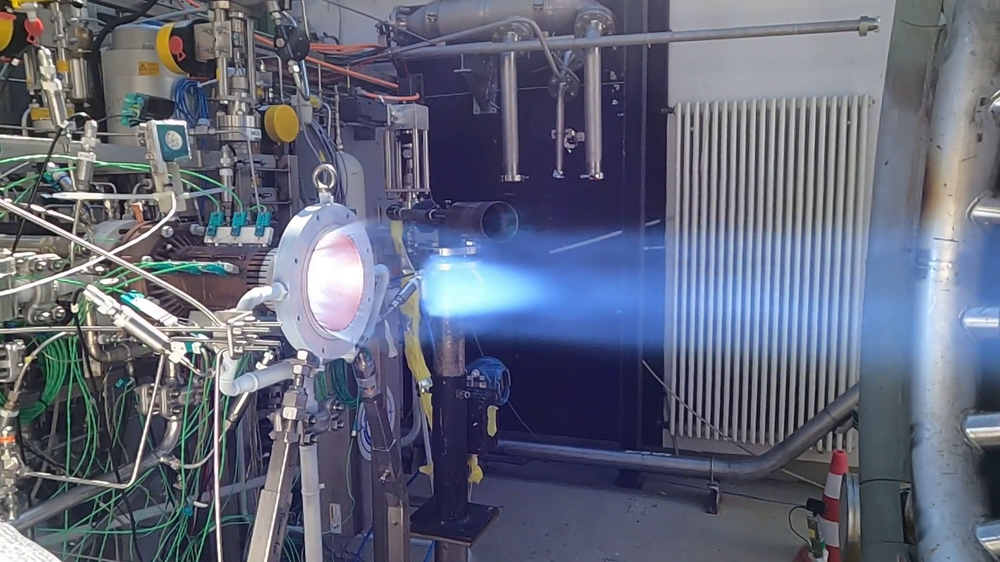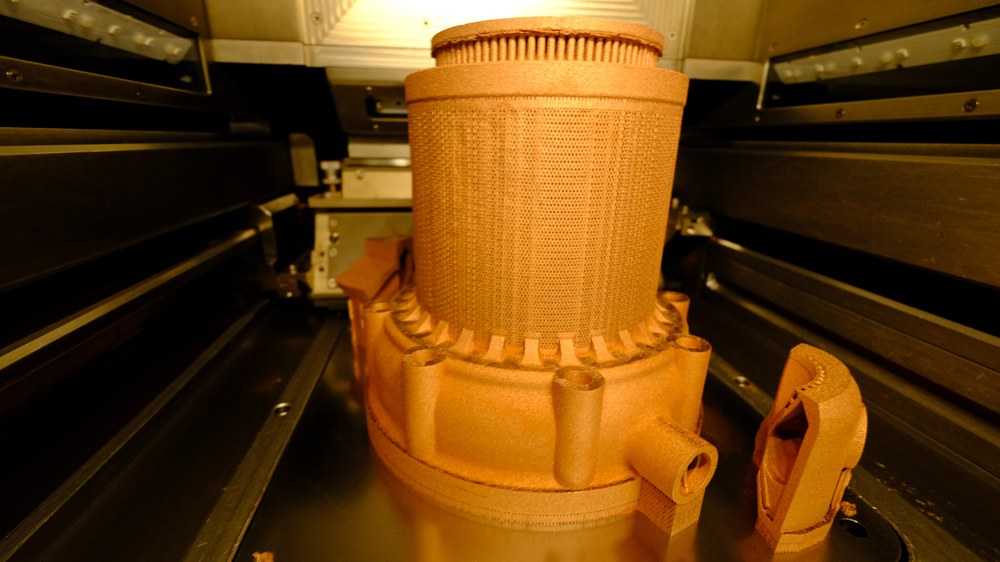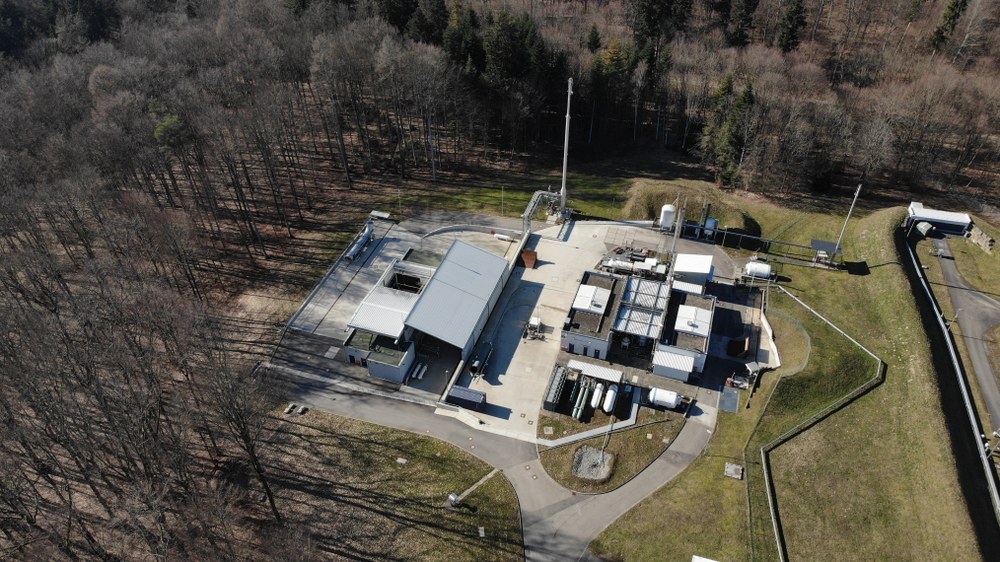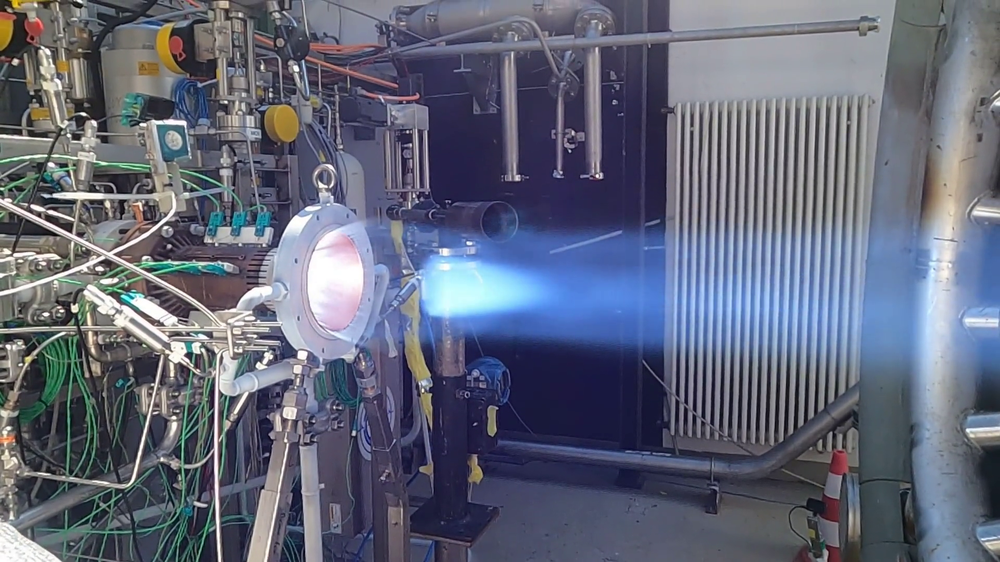DLR develops 3D printing processes for use in spaceflight



- Competition in the space sector is placing new demands on launcher technology, particularly regarding cost reduction and reusability.
- The DLR project 3D-LoCoS has demonstrated that additive manufacturing can play a major role for space propulsion systems in the future.
- Successful hot-fire tests have been completed with a 3D-printed combustion chamber on the European P8 research and technology test stand at DLR Lampoldshausen.
- Focus: Spaceflight, additive manufacturing, digitalisation, artificial intelligence
Maximum safety, high performance and a long service life are important requirements that space propulsion systems must meet. Current propulsion technologies already succeed here, but how do they perform regarding cost-effectiveness and reusability? These are important criteria for being competitive. Researchers at the German Aerospace Center (Deutsches Zentrums für Luft- und Raumfahrt; DLR) are focusing on these characteristics in the 3D Printing for Low-Cost Space Components (3D-LoCoS) project. The emphasis is on the further development and application of metal-based additive manufacturing – that is, 3D printing processes. These methods make it possible to produce technology demonstrators for new space components more quickly and cost-effectively.
Cost reduction as a competitive factor in the space sector
"New manufacturing processes are the key to increased performance, improved cost-effectiveness and pave the way for reusable launcher technologies," says Jan Haubrich, Project Leader at the DLR Institute of Materials Research. Interdisciplinary teams from the Institute of Structures and Design, the Institute of Space Propulsion, the Institute for Software Technology and the Institute of Materials Research are working together on the 3D-LoCoS project. The aim is to expand the possible applications of the 'Laser Powder Bed Fusion' (LPBF) additive manufacturing process. The LPBF method is suitable for particularly complex or intricate structures.
"We have designed and developed a combustion chamber with a special regenerative cooling concept specifically for the additive LPBF manufacturing process," says Dmitry Suslov from the DLR Institute of Space Propulsion. An alloy of copper, chromium and zirconium makes the material of the combustion chamber highly thermally conductive and heat resistant.
New manufacturing process on the P8 test stand
Hot-fire tests on the P8 research and technology test stand in Lampoldshausen demonstrated that both the design and the manufacturing process of the 3D-printed combustion chamber, which is capable of producing 25 kilonewtons of thrust, were successful. "With six hot-fire tests, we were able to show the great potential of this new fabrication method and the functionality of the 3D-printed combustion chamber," says Suslov. "Now we want to quickly introduce this technology into industrial application. The tests have proven that additive manufacturing offers a wide scope for the design and construction of engine components." Innovative design methods based on artificial intelligence (AI) were also used throughout the project – from the design of the combustion chamber to the implementation of the tests on the test stand.

Video: Test of the 3D-printed combustion chamber with a propellant combination of liquid oxygen and methane
Your consent to the storage of data ('cookies') is required for the playback of this video on Quickchannel.com. You can view and change your current data storage settings at any time under privacy.
The innovation of metal-based additive manufacturing
"Additive manufacturing processes enable an entirely different way of producing components and are a fairly young technology compared to most other processing methods," says Jan Haubrich, indicating the potential for the future: "For complex designs in particular, it enables components to be printed more quickly and cost-effectively." However, materials produced using additive manufacturing behave differently to conventionally processed materials and thus necessitate additional tests and technology development. Follow-up projects will continue to develop the copper combustion chamber into a flight-ready piece of hardware using AI. Cooperation projects are also intended to strengthen the transfer of the technology to industry.
The development of the combustion chamber
The use of 3D printing in the production of a combustion chamber must already be considered during the design phase. This is because the use of the LPBF process results in new requirements that affect properties such as gas impermeability, geometric precision and surface roughness, among other things, which are decisive for the design. For this reason, the researchers first investigated whether 3D printing of the new combustion chamber design was even feasible. The LPBF process and manufacturing strategy was validated by means of material tests and prototypes. The new process enabled the combustion chamber to be manufactured on a fabrication system in a single piece. This system had to be of a special size in order to accommodate the production of a combustion chamber with a length of more than 60 centimetres in one piece.
